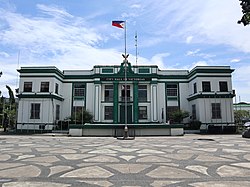Victorias | |
|---|---|
| City of Victorias | |
 City hall | |
| Nicknames: "The Sugarlandia of Negros" "The Sweet and Green City of Negros" | |
 Map of Negros Occidental with Victorias highlighted | |
Location within the Philippines | |
| Coordinates: 10°54′N123°05′E / 10.9°N 123.08°E | |
| Country | Philippines |
| Region | Negros Island Region |
| Province | Negros Occidental |
| District | 3rd district |
| Founded | October 2, 1906 |
| Cityhood | March 21, 1998 |
| Named after | Nuestra Señora de las Victorias (Our Lady of Victory) |
| Barangays | 26 (see Barangays) |
| Government | |
| • Type | Sangguniang Panlungsod |
| • Mayor | Abelardo D. Bantug III (NPC) |
| • Vice Mayor | Francis Frederick "Derek" D. Palanca (NPC) |
| • Representative | Javier Miguel L. Benitez (PFP) |
| • City Council | Members |
| • Electorate | 60,576 voters (2025) |
| Area | |
• Total | 133.92 km2 (51.71 sq mi) |
| Elevation | 166 m (545 ft) |
| Highest elevation | 1,568 m (5,144 ft) |
| Lowest elevation | 0 m (0 ft) |
| Population (2024 census) [3] | |
• Total | 90,290 |
| • Density | 674.2/km2 (1,746/sq mi) |
| • Households | 22,268 |
| Economy | |
| • Income class | 4th city income class |
| • Poverty incidence | 16.56 |
| • Revenue | ₱ 1,011 million (2022) |
| • Assets | ₱ 3,320 million (2022) |
| • Expenditure | ₱ 748.7 million (2022) |
| • Liabilities | ₱ 1,561 million (2022) |
| Service provider | |
| • Electricity | Northern Negros Electric Cooperative (NONECO) |
| Time zone | UTC+8 (PST) |
| ZIP code | 6119 |
| PSGC | |
| IDD : area code | +63 (0)34 |
| Native languages | Hiligaynon Tagalog |
| Website | www |
Victorias, officially the City of Victorias (Hiligaynon : Dakbanwa sang Victorias; Filipino : Lungsod ng Victorias), is a component city in the province of Negros Occidental, Philippines. According to the 2024 census, it has a population of 90,290 people. [5]
Contents
- Geography
- Barangays
- Climate
- Demographics
- Language
- Economy
- Religion
- Churches
- St. Joseph the Worker Chapel
- Festivals
- Sports
- Notable personalities
- Education
- References
- External links
Victorias is notable for the St. Joseph the Worker Chapel, which was declared as an Important Cultural Property of the Philippines [6] in December 2015.
It is also the site of Victorias Milling Company, the world's largest integrated sugar mill, [7] sitting on a 7,000 hectares (17,000 acres) compound that makes it the Philippine's largest sugar refinery.








